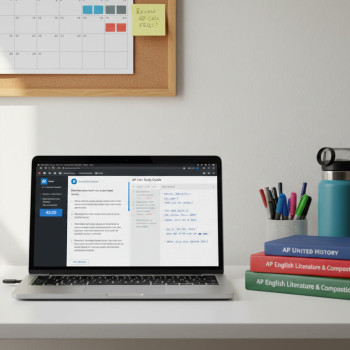The Student Journey of Breaking Score Plateaus
There’s a moment in almost every student’s SAT story when progress stalls. One week you’re improving; the next month feels like a treadmill—lots of effort, very little forward motion. That stuck feeling is what I call the score plateau. If you’ve landed here, this post is for you: a compassionate, practical roadmap to nudge, then push, and finally break through your plateau on the Digital SAT.
Why plateaus happen (and why they’re not failure)
First: take a breath. A plateau isn’t a sign you’re not smart or capable. It’s often a sign that you’ve mastered a certain set of skills and now need a new kind of input to move forward. Common causes:
- Repeating the same types of practice without addressing specific weaknesses.
- Relying on raw quantity of practice instead of quality and reflection.
- Test-day anxiety or poor pacing that masks knowledge on exam day.
- Study plans that are too generic—what helps one student doesn’t always help another.
Understanding why you’ve plateaued is the first step. From there, you can choose smarter actions rather than doubling down on things that aren’t working.
Shift #1 — From random practice to pinpointed practice
When scores quit budging, scattershot practice won’t help. Imagine practicing free throws in basketball without measuring whether you make more right-handed or left-handed shots. On the SAT, you need to diagnose which question types, content areas, or timing problems are holding you back.
How to pinpoint:
- Keep a detailed error log. Record the exact question type, the reason you missed it (concept gap, careless error, timing), and how long you spent.
- Group mistakes into patterns—grammar rules, algebra foundations, multi-step reading comprehension, or calculator misuse.
- Use targeted mini-sessions (20–40 minutes) focusing on one pattern until you see a measurable drop in that error type.
An error log is a small habit that yields huge returns: the next time you practice, you can choose questions that specifically attack your weak points, not random ones.
Shift #2 — Quality over quantity: smarter practice routines
It’s tempting to assume that more practice tests will always equal higher scores. But if you’re not analyzing results effectively, you may just be reinforcing the same mistakes.
Try this structure for practice sessions:
- Warm-up (10–15 minutes): quick review of flashcards or formulas to prime your mind.
- Focused Practice (30–50 minutes): work on targeted question sets—only those aligned with your error log.
- Reflection (15–25 minutes): review every missed question with a short note: “Why I missed it” and “How I’ll avoid it next time.”
- Application (optional 20 minutes): do a few mixed questions to apply corrected strategies under some pressure.
When you keep sessions focused and reflective, each hour of study becomes three times as effective as unfocused hours.
Data-driven review: making numbers work for you
If you want to break a plateau, treat your practice like a small experiment. Track metrics over time so you know what’s helping.
| Metric | Why it matters | How to track |
|---|---|---|
| Error type frequency | Shows persistent weaknesses. | Use your error log to count occurrences weekly. |
| Average time per question | Reveals pacing issues or overthinking. | Time every question during practice tests; chart averages by section. |
| Score on targeted mini-tests | Measures improvement on a specific skill. | Design 12–20 question quizzes focused on one skill and retake weekly. |
| Proportion of careless vs. conceptual errors | Shows whether you need focus work or content review. | Tag each mistake as “careless” or “conceptual” in your log. |
Seeing progress in numbers—even small wins like a 10% drop in careless errors—boosts confidence and shows that your changes are working.
Time management: pacing as a skill, not an afterthought
Pacing is often the unseen enemy of higher scores. You may know the content, but if you run out of time, your raw knowledge doesn’t convert into points.
Practical pacing strategies:
- Practice sections with a visible timer and simulate digital test navigation (flagging, back-and-forth movement).
- Adopt a triage system: quick-scan the section, do all easy questions first, then medium, then hard. Leave only the hardest for last.
- Learn to recognize a question that’s taking too long—set a personal threshold (e.g., 1.5x the average time)—and move on. Flag it for review if time permits.
On the Digital SAT especially, navigation is different from paper: you can flag questions and jump around more fluidly, but that flexibility requires a strategy. Practice using those features so they feel natural on test day.
Mindset matters — how to manage frustration and maintain momentum
Plateaus can feel demoralizing. The difference between a student who gives up and one who pushes through is often mindset, not ability. Here are practical mindset tools:
- Reframe setbacks as feedback, not judgment. A missed question is data, not a verdict on your intelligence.
- Set process goals, not only outcome goals. For example: “Complete 4 targeted mini-sessions this week” is more controllable and motivating than “gain 80 points this month.”
- Celebrate small wins. Reduced time per question, fewer careless errors, or improved endurance during full-length sections are all worthy milestones.
Remember: consistency compounds. Showing up thoughtfully every day builds the habits that eventually produce score leaps.
Study plan archetypes — choose one that fits your life
There’s no single perfect study plan—only the one that fits your schedule and learning style. Below are three archetypes. Pick one, then modify it to your reality.
- Structured Daily — 60–90 minutes/day, 5–6 days/week. Best if you have steady weekday availability. Mix targeted practice, vocabulary/grammar drills, and one full section on weekends.
- Block Weekender — 3–4 hour blocks on two weekend days plus 30–45 minute weekday touch-ups. Good for busy students with packed weekdays.
- Intensive Sprint — 2–3 hours/day for a 3–6 week period before a test. Useful if you’re close to test day and need to focus intensely on specific weaknesses.
Whichever you choose, reserve at least one full-length Digital SAT practice test every 10–14 days to calibrate pacing and endurance.
How to review a full practice test (so you actually learn)
Many students take a practice test and only glance at their score. Instead, treat test review like a forensic investigation:
- Record the raw data: correct/incorrect by question number and reported reasoning for each miss.
- Categorize every miss: concept gap, careless error, misread, timing, or strategy failure.
- For each category, plan a concrete fix: example—if misreads are common, practice active reading strategies for 20 minutes daily.
- Retake a short, focused quiz on the same concepts within 48–72 hours to lock in corrections.
A single well-reviewed practice test is more valuable than three tests that are only scored.
Active learning techniques that beat passive review
Active learning is any technique where you push your brain to retrieve, apply, or explain information. It’s far more powerful than rereading notes.
- Teach it: explain a tricky grammar rule or math concept aloud, as if teaching a friend.
- Self-quizzing: closed-book recall of formulas, rules, or the steps for solving a problem type.
- Interleaving: mix problem types within a study block to train flexible thinking—don’t always isolate one skill for long stretches.
These techniques strengthen long-term retention and make transfer to the test much smoother.
When to bring in help — the power of personalized tutoring
If you’ve tried the strategies above consistently and still feel stuck, targeted support can accelerate progress. Personalized tutoring offers three big benefits:
- 1-on-1 guidance to identify subtle misconceptions that aren’t obvious in a log.
- Tailored study plans that save you time by focusing only on what moves your score.
- Expert feedback and accountability to keep momentum through tough patches.
For many students, a few weeks of focused tutoring—especially with tutors who know the Digital SAT’s format and common traps—transforms plateaued efforts into measurable improvement. Sparkl’s personalized tutoring, for example, blends expert tutors with AI-driven insights to create efficient, individualized plans and real-time feedback that fit naturally into a student’s routine.
Practical tools and routines you can adopt this week
Here’s a short starter kit you can implement immediately to begin chipping away at your plateau:
- Create an error log template (spreadsheet or notebook). Each entry: question #, type, error cause, time spent, corrective action.
- Block out four 45-minute sessions this week: two for targeted practice, one for a timed section, one for review and reflection.
- Perform one short diagnostic to identify the top two error patterns to attack for the next two weeks.
- Try a “micro-teaching” habit: explain a tricky question or concept out loud for two minutes each study session.
Real-world examples: students who broke through
To make this concrete, here are three short, composite stories based on common student experiences:
- Jasmine: Stalled at a 1200. Her logs showed many careless reading errors. She adopted active reading (annotating passage structure) and reduced careless mistakes by half in four weeks. Her score jumped 80 points.
- Devon: Plateaued at a 1360 because of timing. He started triage practice and timed mini-sessions. Learning to triage saved him 12 points in the first month.
- Maya: Improved from 1040 to 1220 by combining targeted practice on algebra foundations with weekly tutor sessions. Personalized lessons corrected a single recurring misconception that unlocked many questions.
These stories show how a focused, data-driven change—sometimes tiny—can produce a meaningful score increase.
How to set realistic progress goals
Ambitious goals are great, but unrealistic ones create burnout. A reasonable pace is to aim for a 30–70 point improvement over 4–6 weeks with consistent, targeted work. Larger gains are possible, especially for students who correct major conceptual gaps, but they usually require sustained effort across several months.
Use short intervals (2-week check-ins) to adjust your tactics. If one approach isn’t moving the needle after two cycles, pivot to something different: change your practice structure, add tutoring, or alter pacing strategies.
Nutrition, sleep, and test performance—don’t ignore the basics
It’s easy to view SAT prep as purely intellectual work. But your brain is biological. Adequate sleep, steady nutrition, and regular movement show up in performance more than students expect. Simple habits that help:
- 7–9 hours of sleep per night during intense prep phases.
- Small, balanced meals on study days to avoid afternoon crashes.
- Short physical activity bursts (10–20 minutes) before practice to boost focus.
Think of these as performance hygiene: small habits that protect the gains you’re working hard to make.
Putting it all together — a sample 8-week recovery plan
Below is a compact 8-week plan for a student aiming to break a plateau and gain consistency. Customize the time blocks to fit your life.
| Weeks | Focus | Weekly Routine | Goal |
|---|---|---|---|
| 1–2 | Diagnosis & baseline | 1 full practice test, error log setup, 3 targeted sessions | Identify top 2 error patterns |
| 3–4 | Targeted correction | 4 focused sessions (skill drills), 1 timed section, 1 review session | Reduce targeted errors by 30% |
| 5–6 | Pacing & endurance | 2 half-tests, pacing drills, continued targeted practice | Improve pacing, decrease timing mistakes |
| 7–8 | Polish & consolidation | 1 full test every 10 days, error refinement, rest strategies | Convert improvements into consistent test performance |
When test day arrives — rituals that reduce anxiety
As the test date approaches, your goal shifts from learning to performance. Rituals help steady nerves:
- Night-before checklist: sleep, materials gathered (chargers, allowed calculator if you use one for practice), healthy breakfast planned.
- Morning routine: brief warm-up questions, 5-minute breathing exercise, and a quick glance at the top 3 strategies you want to remember.
- Pacing anchor: at the start of each section, mentally note the triage plan and your average time goal per question.
These rituals reduce decision fatigue and make you less likely to revert to old, inefficient habits under pressure.
Balancing the long view with the short game
Breaking a plateau is rarely a single event—it’s a series of adjustments. Be patient and iterative: experiment with methods, measure results, and refine. Combine smart self-study with occasional outside input when you hit persistent roadblocks. That outside input might be a teacher, an online coach, or a personalized tutor who can point out things you don’t see on your own.
Remember that tools like Sparkl’s personalized tutoring exist to provide exactly this kind of tailored, data-informed support—matching expert tutors to your needs and giving you a study plan that respects your life and accelerates progress.
Final thoughts — this is your journey
Score plateaus are common, but they’re also conquerable. The students who break through aren’t necessarily the ones who study longest—they’re the ones who study smarter, reflect honestly on their mistakes, and adapt with curiosity rather than discouragement. Use targeted practice, track your metrics, optimize pacing, and don’t hesitate to bring in a tutor when the benefit outweighs the time you’d spend guessing at fixes.
If you treat each practice session as an experiment—collect the data, try an intervention, measure the outcome—you’ll be surprised how steadily those small changes compound. And when the score finally moves, the feeling of breaking through is worth all the hard work: it’s proof that incremental, thoughtful effort wins.
Ready to get unstuck? Start this week with a focused error log and one targeted practice session. If you want a hand designing a plan that fits your life and pushes past your plateau, consider reaching out for personalized tutoring that matches your exact needs and keeps you accountable. Your best score is closer than you think.
Short checklist to break your plateau (to save or screenshot)
- Start an error log today.
- Do 3 targeted practice blocks this week.
- Take one full-length Digital SAT practice test every 10–14 days.
- Use active learning (teach, self-quiz, interleave).
- Prioritize sleep, nutrition, and brief physical activity.
- If stuck after 4–6 weeks, consider personalized tutoring for focused acceleration.
Good luck—glad you’re on the journey. Break the plateau, find the groove, and let preparation lead to real confidence on test day.















No Comments
Leave a comment Cancel